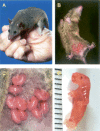The opossum genome: insights and opportunities from an alternative mammal
- PMID: 18676819
- PMCID: PMC3960011
- DOI: 10.1101/gr.065326.107
The opossum genome: insights and opportunities from an alternative mammal
Abstract
The strategic importance of the genome sequence of the gray, short-tailed opossum, Monodelphis domestica, accrues from both the unique phylogenetic position of metatherian (marsupial) mammals and the fundamental biologic characteristics of metatherians that distinguish them from other mammalian species. Metatherian and eutherian (placental) mammals are more closely related to one another than to other vertebrate groups, and owing to this close relationship they share fundamentally similar genetic structures and molecular processes. However, during their long evolutionary separation these alternative mammals have developed distinctive anatomical, physiologic, and genetic features that hold tremendous potential for examining relationships between the molecular structures of mammalian genomes and the functional attributes of their components. Comparative analyses using the opossum genome have already provided a wealth of new evidence regarding the importance of noncoding elements in the evolution of mammalian genomes, the role of transposable elements in driving genomic innovation, and the relationships between recombination rate, nucleotide composition, and the genomic distributions of repetitive elements. The genome sequence is also beginning to enlarge our understanding of the evolution and function of the vertebrate immune system, and it provides an alternative model for investigating mechanisms of genomic imprinting. Equally important, availability of the genome sequence is fostering the development of new research tools for physical and functional genomic analyses of M. domestica that are expanding its versatility as an experimental system for a broad range of research applications in basic biology and biomedically oriented research.
Figures




Similar articles
-
Genome of the marsupial Monodelphis domestica reveals innovation in non-coding sequences.Nature. 2007 May 10;447(7141):167-77. doi: 10.1038/nature05805. Nature. 2007. PMID: 17495919
-
First-generation linkage map of the gray, short-tailed opossum, Monodelphis domestica, reveals genome-wide reduction in female recombination rates.Genetics. 2004 Jan;166(1):307-29. doi: 10.1534/genetics.166.1.307. Genetics. 2004. PMID: 15020427 Free PMC article.
-
Targeted gene disruption in a marsupial, Monodelphis domestica, by CRISPR/Cas9 genome editing.Curr Biol. 2021 Sep 13;31(17):3956-3963.e4. doi: 10.1016/j.cub.2021.06.056. Epub 2021 Jul 21. Curr Biol. 2021. PMID: 34293331
-
Gamete biology of the new world marsupial, the grey short-tailed opossum, Monodelphis domestica.Reprod Fertil Dev. 1996;8(4):605-15. doi: 10.1071/rd9960605. Reprod Fertil Dev. 1996. PMID: 8870084 Review.
-
The origin and evolution of genomic imprinting and viviparity in mammals.Philos Trans R Soc Lond B Biol Sci. 2013 Jan 5;368(1609):20120151. doi: 10.1098/rstb.2012.0151. Philos Trans R Soc Lond B Biol Sci. 2013. PMID: 23166401 Free PMC article. Review.
Cited by
-
A milieu of regulatory elements in the epidermal differentiation complex syntenic block: implications for atopic dermatitis and psoriasis.Hum Mol Genet. 2010 Apr 15;19(8):1453-60. doi: 10.1093/hmg/ddq019. Epub 2010 Jan 20. Hum Mol Genet. 2010. PMID: 20089530 Free PMC article.
-
Mapping the prion protein distribution in marsupials: insights from comparing opossum with mouse CNS.PLoS One. 2012;7(11):e50370. doi: 10.1371/journal.pone.0050370. Epub 2012 Nov 29. PLoS One. 2012. PMID: 23209725 Free PMC article.
-
SOX2 and SOX9 Expression in Developing Postnatal Opossum (Monodelphis domestica) Cortex.Biomolecules. 2024 Jan 5;14(1):70. doi: 10.3390/biom14010070. Biomolecules. 2024. PMID: 38254670 Free PMC article.
-
Blood transcriptome responses to PFOA and GenX treatment in the marsupial biomedical model Monodelphis domestica.Front Genet. 2023 Feb 15;14:1073461. doi: 10.3389/fgene.2023.1073461. eCollection 2023. Front Genet. 2023. PMID: 36873954 Free PMC article.
-
American marsupials chromosomes: Why study them?Genet Mol Biol. 2009 Oct;32(4):675-87. doi: 10.1590/S1415-47572009005000084. Epub 2009 Dec 1. Genet Mol Biol. 2009. PMID: 21637437 Free PMC article.
References
-
- Ager E., Suzuki S., Pask A., Shaw G., Ishino F., Renfree M.B. Insulin is imprinted in the placenta of the marsupial, Macropus eugenii. Dev. Biol. 2007;309:317–328. - PubMed
-
- Baker M.L., Belov K., Miller R.D. Unusually similar patterns of antibody V segment diversity in distantly related marsupials. J. Immunol. 2005;174:5665–5671. - PubMed
-
- Behringer R.R., Eakin G.S., Renfree M.B. Mammalian diversity: Gametes, embryos and reproduction. Reprod. Fertil. Dev. 2006;18:99–107. - PubMed
-
- Bejerano G., Haussler D., Blanchette M. Into the heart of darkness: Large-scale clustering of human non-coding DNA. Bioinformatics. 2004;(Suppl. 1) 20:i40–i48. - PubMed
-
- Belle E.M., Duret L., Galtier N., Eyre-Walker A. The decline of isochores in mammals: An assessment of the GC content variation along the mammalian phylogeny. J. Mol. Evol. 2004;58:653–660. - PubMed
Publication types
MeSH terms
Substances
Grants and funding
LinkOut - more resources
Full Text Sources
